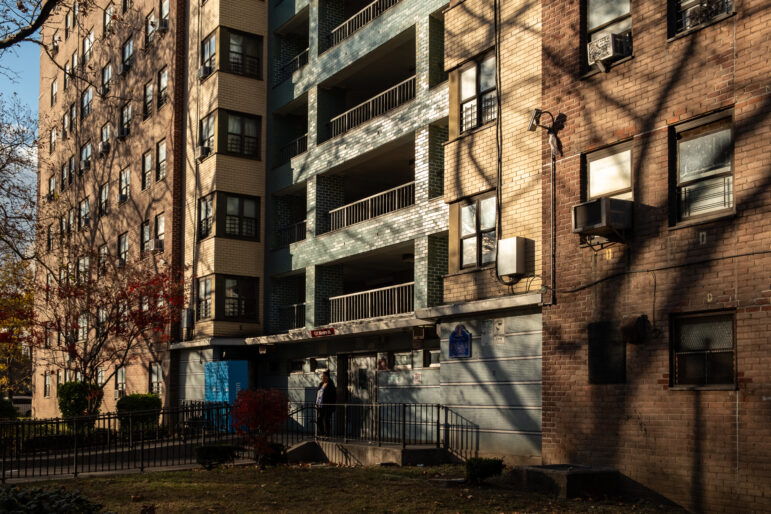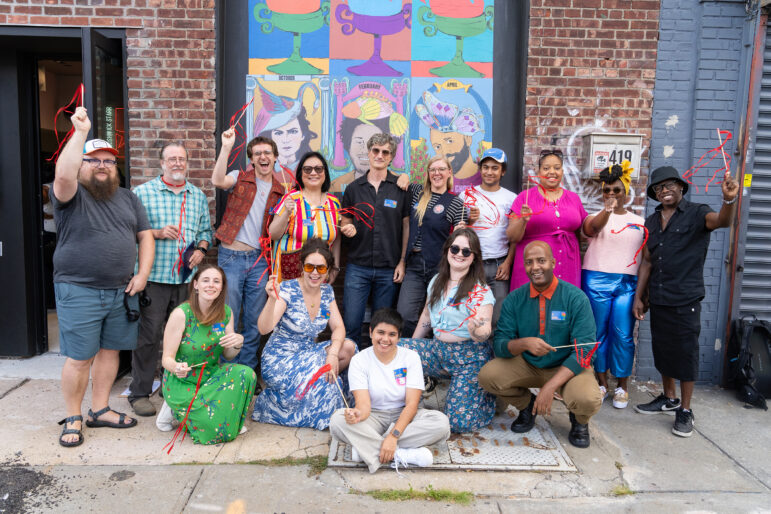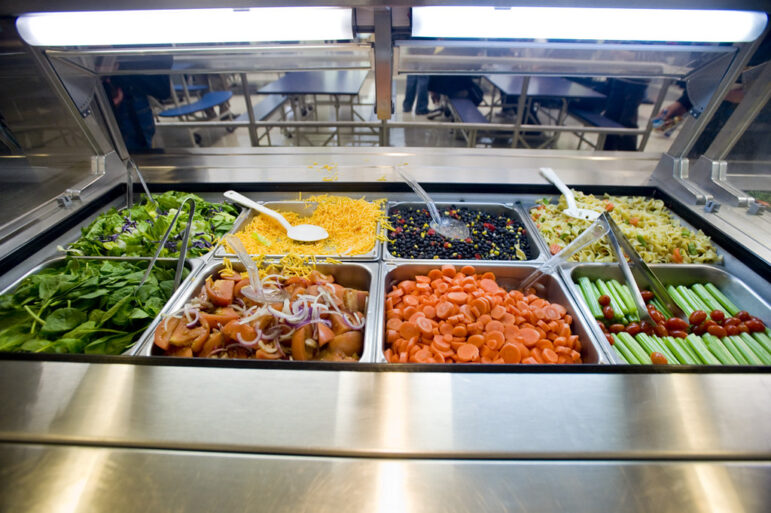
Mayor's Office
Mayor Bloomberg and other officials at a 2011 groundbreaking for new industrial space. The Bloomberg administration launched programs to aid manufacturing, but also oversaw rezonings that threatened it. Mayor De Blasio’s approach remains to be seen.
After decades of heavy losses in manufacturing employment, the sector’s continued demise in New York City has seemed as natural and inevitable as rising rents and proliferating chain stores. A dwindling manufacturing sector was just a fact of life in the modern city.
But in 2012 something unexpected happened: The job losses leveled off, leading some to wonder whether the manufacturing sector is primed for a revival.
With manufacturing employment at 76,000 jobs today, it will take a long, hard climb before this sector is back to the 201,000 jobs it had in 1997. But the success of an organization like the Greenpoint Manufacturing and Design Center (GMDC), which is set to expand its portfolio of manufacturing buildings to include 1102 Atlantic Avenue in Crown Heights, shows that at least modest growth in manufacturing employment is within reach.
“I doubt we will see manufacturing coming back to the levels that it was decades ago,” says GMDC’s CEO Brian Coleman, “but I do believe that there are factors that would suggest that manufacturing can improve compared to its most recent levels.”
One question is how far the de Blasio administration will go to preserve the city’s remaining manufacturing zones, an important issue for many of Mayor de Blasio’s fellow progressives. At the same time, the administration is wresting with competing policy goals, like finding room to build affordable housing, and ensuring emerging technology and creative businesses can find room to take root in the city. In both instances some are eying manufacturing zones.
Scarce space
Demand for industrial properties is strong. GMDC has zero vacancy in its four North Brooklyn industrial buildings, which together have over 500,000 square feet of space, 100 businesses, and 530 employees. Now GMDC is expanding into a 50,000 square foot former auto parts warehouse in Crown Heights to meet excess demand. And even though 1102 Atlantic Avenue won’t be open until next year, nearly half the space is already pre-leased.
“It’s no accident that we literally have no vacancy in our existing buildings and leased five of the twelve units on Atlantic Avenue,” says Coleman.
The biggest obstacle to a manufacturing comeback in New York City is real estate. Suitable properties are scarce, and the city’s manufacturing zones have shrunk over the past decade due to Bloomberg-era rezonings. Because commercial uses are also allowed in manufacturing zones, manufacturers must compete with hotels, offices, nightclubs, and bowling alleys for properties. All told, the amount of land consisting of industrial uses fell by 14 percent between 2000 and 2013, according to property tax data that classifies land by use.
These pressures are most acute in areas bordering hot real estate markets like Williamsburg, Greenpoint, and Long Island City, where the number of manufacturing firms fell from 850 in 2002 to 572 in 2012. On Manhattan’s west side, in neighborhoods along the High Line, the number of manufacturers fell 42 percent over the same time period, from 2,059 to 1,203.
A manufacturing model
GMDC’s expansion at 1102 Atlantic Avenue sits amidst a nine-block stretch of land zoned for manufacturing, just east of the Barclays Center. Much of this land is underdeveloped, with vacant or open lots scattered throughout, a point made more glaring by the fact that it is surrounded by some of the city’s most rapidly developing neighborhoods. It’s easy to imagine new apartment buildings rising here, if residential uses were allowed.
There are only two-dozen manufacturing firms in the area today; businesses like storage centers, restaurant supply companies, and gas stations are more common. But the fact that half of the space at 1102 is already pre-leased suggests that more manufacturers would make Crown Heights home if there were more suitable properties.
At 1102 Atlantic Avenue, the $15 million project was made possible with $4.6 million in city support, plus the allocation of federal New Market Tax Credits which help offset the cost of financing. Subsidies are what make GMDC’s non-profit model work. GMDC offers tenants discounted rents approximately 20 percent below market value. It also offers long-term leases, which in turn allow tenants to make long-term plans and investments without having to worry about being priced out when the lease expires.
By acquiring and upgrading seven buildings since 1994, GMDC has insulated its manufacturing tenants in North Brooklyn from the cruel whims of the real estate market. With its newest acquisition in Crown Heights, it has established another beachhead against the rapid conversion of industrial spaces to other uses. “It’s going to be one additional property that we secure for our borough,” says Diana Reyna, Deputy Borough President under Eric Adams and a former city councilmember representing Greenpoint and Williamsburg.
De Blasio’s policy unclear
Reyna notes that GMDC is one organization within a larger ecosystem of industrial non-profits operating in Brooklyn. “The Brooklyn Navy Yard learned from [GMDC’s] model,” she says. “A lot of other organizations have learned from this model and have seen how industry is looking for this type of model.”
Reyna talks of the East Williamsburg Valley Industrial Development Corporation and the Southwest Brooklyn Industrial Development Corporation. “Within their boundaries EWVIDCO has well over 15,000 jobs,” says Reyna. “Everyone talks about Navy Yard, but what I want people to understand is that the Navy Yard has only a quarter of that.”
EWVIDCO owns some property in North Brooklyn and manages the Greenpoint-Williamsburg Industrial Business Zone (IBZ) and the North Brooklyn IBZ. The IBZ program was set up under Mayor Bloomberg to support industry by funding services for businesses within the city’s 21 IBZs. The IBZ designation was also said to be a “pledge” by the Bloomberg administration that it would not modify the zoning in these areas. In practice, commercial uses are still allowed and continue to nibble away at these zones, and some wonder if under de Blasio the city’s pledge will hold.
De Blasio eliminated funding for the Industrial Business Zone program in his first budget. According to administration spokesman Wiley Norvell, “Spending differences in a single program do not speak to the overall commitment to industrial firms and their jobs.”
“The de Blasio administration is committed to making smart, impactful investments that will help manufacturing thrive in New York City,” according to Norvell, “and is working with our agency partners to take a fresh look at the suite of programs that support this critical part of the city economy.”
Among the de Blasio administration’s initiatives to support manufacturing, the mayor has called for a $100 million investment at the Brooklyn Army Terminal to rehabilitate 500,000 square feet of space for industrial companies.
“I don’t think we’ve heard enough,” Coleman says of the administration’s support of manufacturing. “It’s an incomplete so far. They’ve obviously got a very aggressive housing agenda, but will it be at the expense of manufacturing? I don’t know at this time.”
More mixed use?
Other administration officials have talked of encouraging mixed uses, including residential uses, in manufacturing zones. At a Citizens Budget Commission breakfast earlier this year, Deputy Mayor Alicia Glen said, “There could be opportunities to do in these zones … modern manufacturing, manufacturing that coexists really well with other uses.”
Glen continued, “What we’ve thrown out to the planning department is to create a new zoning classification that creatively allows people to have density and mixed uses more in concert with things we’re seeing in northern Europe and other smart transformative cites that are trying to create and retain amazing jobs.”
While speaking about manufacturing zones in Long Island City in June, Planning Commissioner Carl Weisbrod also suggested that the city may allow residential uses in manufacturing zones. In Long Island City the administration “might be able to look at a topography that we’ve really not seen much of in the city of New York, and that is modern-day manufacturing and residential in the same building, literally.”
But would allowing mixed uses make it impossible for manufacturers and craftsmen to compete for properties? Is it possible for manufacturing, even light manufacturing, to coexist with apartments and offices?
Coleman says that he isn’t necessarily opposed to the idea of having residential uses on top of light manufacturing uses. “We’ve looked at the model,” Coleman says. “Operationally, I’m not sure how something like that would work. Ultimately there are sensitivity issues when you have a residence above any kind of manufacturing space.”
On the other hand, building apartments above manufacturing space provides the opportunity to cross subsidize manufacturing uses—higher rents per square foot for residential units could help offset the cost of providing manufacturing space. However, this type of cross-subsidization wouldn’t work if the apartments consisted of affordable housing.
Weisbrod also suggested that space for manufacturing could grow by building up. “Technology has changed where now you can go vertical for industrial use, allowing businesses to expand. I believe we are beginning to look at that,” Weisbrod said in June.
Constructing new vertical industrial buildings would be a challenge because the rents paid by manufacturing tenants tend not to cover the cost of construction. “It’s not like you have developers eager to build industrial buildings,” says Reyna, “When was the last time we built an industrial building?”
One has to wonder whether “vertical manufacturing” is another word for commercial office space, which commands higher rents. Many formerly industrial buildings are being converted into office space, especially the type that appeals to tech and creative tenants that want non-traditional office layouts.
“Kickstarter just moved into a building here in Greenpoint,” observes Coleman, “When you have office spaces occupying industrial property you’re driving up the market.” GMDC will have offices next door in Crown Heights as well. 1000 Dean Street, just around the corner form 1102 Atlantic Avenue, was recently converted into “creative offices and studios” with a food and beer hall on the ground floor.
A broader case for manufacturing
To Reyna, there should be more distinction between commercial uses and manufacturing uses in manufacturing zones. The city should “preserve those spaces for industry,” Reyna says, because “it is harder to come by that kind of space” for manufacturers. Reyna has called for the de Blasio administration to re-commit to the IBZ program and to appoint a new head of the Office of Industrial and Manufacturing Businesses, a spot left vacant since 2006.
Perhaps the best way to support manufacturing would be through capital grants for organizations like GMDC, EWVIDCO, and the Navy Yard. Reyna also points to a $20 million fund for manufacturers that was established during the Greenpoint-Williamsburg rezoning in 2005. The fund helped GMDC to rehabilitate a property in East Williamsburg with a $3.5 million grant.
Still, the city must weigh these investments with those for other sectors of the economy, including technology. A report commissioned by the Association for a Better New York notes that the city’s “tech ecosystem” includes 128,000 jobs that are accessible to—though not necessarily held by—people without a bachelor’s degree. These jobs pay from $24 to $32 an hour.
This is higher pay than offered by most jobs within the manufacturing sector, according to a new report by the city’s Independent Budget Office. Those without a bachelor’s degree working in furniture manufacturing earn about $19 an hour, and similarly trained employees of food manufacturers earn $17.33 an hour.
The IBO numbers could undermine one familiar argument for manufacturing, namely that it offers a substantially better standard of living to less-educated workers than alternatives industries.
But it’s important to note that although jobs in the tech ecosystem may be “accessible” to those without a bachelor’s degree, in practice most jobs are held by those with college degrees. Manufacturing advocates also point out that manufacturing jobs provide good access to health care and benefits, better schedules, and opportunities for on-the-job training and advancement that don’t exist in retail or food service. And in manufacturing and industrial, many people work for 20 or 30 years at the same place.
Then there is the fact that, as Coleman notes, not everyone wants to work on a computer. “Some people need to work with their hands.”
Adam Friedman, the executive director at the Pratt Center for Community Development, agrees.
“New Yorkers have an incredible range of talents and ambitions and the city needs a diverse economy to create the entrepreneurial and employment opportunities for its residents to capitalize on their talents,” he says. “I’ve been on countless factory tours and inevitably at some point the owner introduces me to a senior manager who started off pushing a broom or on some relatively unskilled task.”








